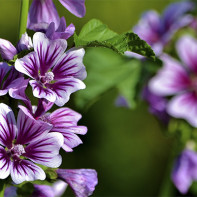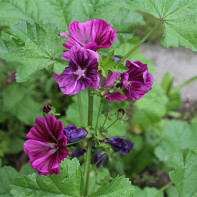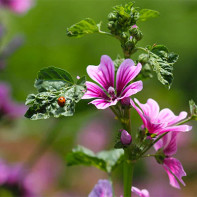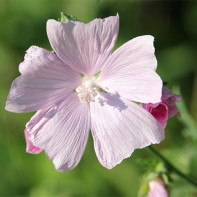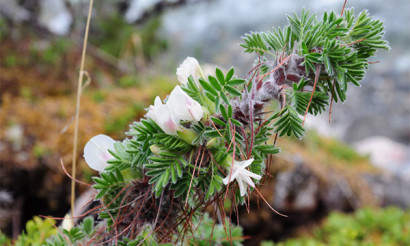Malva forest: medicinal properties and contraindications
Malva forestry is an extremely useful herbaceous plant. Due to the content of a whole list of useful components, including many vitamins, is widely used not only in medicine, but also in cooking and cosmetology.
- Chemical composition
- How it looks and where it grows
- Gathering and storage
- Therapeutic properties of the wood mallow
- Malva forest in folk medicine
- Infusion on mallow
- Cold infusion on the leaves of the forest mallow
- Anti-inflammatory infusion
- Infusion against bad cough
- Infusion on stems and green leaves
- Infusion from the juice of the mallow tree
- Infusion to help with anemia
- Healing compositions
- Infusion
- Infusion
- Decoction
- Cosmetic Applications
- Malva in cooking
- Soup with wild green plants
- Omelette with medicinal herb
- Okochka with radish and mallow
- Casserole with rosemary mallow and herbs
- Braised mallow forest stew with greens
- Contraindications for use
Chemical Composition
The chemical composition of the plant is extremely rich. It is this fact that allows its use for the treatment and prevention of various diseases of the human body, widely used in cosmetology and cooking.
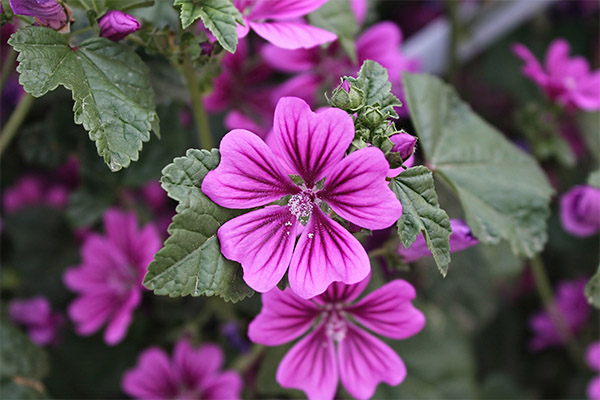
In the mallow forest, experts found the content of the following medicinal chemical components:
- Phenolcarboxylic acids (including ferulic acid).
- Terpenoid compounds (diterpenoids, monoterpenoids, norsesquiterpenoids).
- Phenols and their derivatives (tyrosol and 4-hydroxybenzyl alcohol).
- Coumarin (copoletin).
The green leaves of the plant are rich in flavonoids and the flowers are rich in anthocyanins (pigments). The massive stems and leaves are full of fatty acids. The fruits contain medicinal chemical elements such as acids (sterculic, mallow and dihydrostercular) and fatty oil (up to 20%). In addition, all the above-ground parts of the healing plant are rich in vitamins. Vitamins C and A are present in greater amounts. In addition to vitamins, the above-ground parts have mucilaginous and tannins, as well as sucrose.
What it looks like and where it grows
The forest mallow is known around the world for its incredible fertility. The herbaceous perennial plant has a sprawling appearance and a very long flowering period. Its size depends directly on natural conditions. Thus, the plant can vary in height from 50 to 130 cm, in width its size varies less - from 40 to 65 cm. In nature, it is easy to find specimens more than 3 m in height.
The plant is also known by another name. Often you can hear that the mallow is called a common mallow. The leaves of this plant always have a round shape and a rich green color. You can always see an odd number of lobes on them. There can be either 3 or 9 of them. The size of the green leaves is not small. Each leaf may vary from 1.5 to 4.5 cm in height and a little more in width, from 3 to 6 cm. The upper part of the leaves is always covered with many branching veins, and you can often feel the fine villi from the inside. Throughout the summer, the stems and leaflets of the plant begin to have a shabby appearance.
During the long flowering period, bunches of flowers form on large, thick, round stems. They grow in different places in clusters of an average of 2-5 in one place. Each flower is large enough, its diameter is about 6 cm. The flower has 5 large petals, colored in rich purple. Each petal has many veins, and the purple color intensifies from the center to the edges.
The flowering period of the forest mallow begins in summer and ends in late fall. The very first flowers appear at the very base of the stems. The plant attracts neither bees nor butterflies and is self-pollinating. After the flowers blossom, fruits in the form of nuts or fruits, the so-called "semifruits", appear in their place. Inside them are the seeds of the plant, which have a brown color.
Mulberry is a member of the large Malva family, which includes more than 1000 different species. Most of the plants of this family can be found in tropical latitudes of the globe. The wood mallow is found in the wild only in North Africa, Asia, partly in Europe and the UK. It is these areas that are considered the home of the species. Here the crop grows in common wet forest soils. In other countries, however, the woodland mallow is beautifully cultivated and valued by gardeners.
Gathering and storage
Traditional medicine in the preparation of various medicines from the mallow forest uses absolutely all parts of the plant, starting from the rhizomes and ending with the flowers and seeds. All the green part, which is above the ground, should be collected before the beginning of the flowering period. When harvesting, the leaves, including petioles, should be cut off no more than 3 cm in size. So the green leaflets can be harvested from July to October. Flowers should be harvested when they are still budding, with their corolla and petals beginning to turn bright pink. The main thing is that the stamens have not yet appeared. As for rhizomes, they are harvested only in the fall.
Collected at a certain time, the necessary parts of the plant should be dried in a special way. Only in this case it will be possible to preserve all the healing and useful properties of the forest mallow. Preliminarily you need to crush the parts of the plant, then lay outdoors in hot weather. It is important that the plant is not exposed to direct sunlight. The tray should be in the shade, and the pieces themselves should be spread in a single layer. If there is no possibility to perform drying outdoors, you can also do it indoors, following the same instructions. After proper drying, the flowers, rhizomes and leaves collected in jars can be stored for 2 years.
Medicinal properties of the forest mallow
Such a rich history of using the forest mallow as a medicinal plant came about due to its special mucilage content. It is the one that has special effects of moisturizing and soothing pain. Among all its species congeners, the forest mallow is far from being a species that is rich in mucilage. However, in areas where mucus-rich plants are not found in the wild, it is the forest mallow that people actively use. The highest content of medicinal mucus is noted exactly in the fruit and its seeds. From them most often prepare decoctions and special teas for internal use.
To treat various mechanical injuries of the skin surface (wounds, bites, cuts, etc.) people actively use the leaves of the mallow, making special poultices from them. From the rhizomes, seeds and fruits of the plant make a valuable volatile oil. It is the oil that perfectly helps to cope with toothache and insomnia, and also has antibacterial, astringent and antifungal properties.
In European countries, it is customary to soften the mucous membranes of the mouth if a person is suffering from a dry cough. In addition, the plant eliminates respiratory disorders. Also mallow is great for bronchial disorders. If you take it internally, you will notice that the chemical elements contained in the herbaceous plant have a favorable calming effect on the central nervous system of the body. This helps to bring a person to a calm state, to relieve nervousness and stress.
Unique usefulness of mallow forest and a variety of diseases of the digestive system and urinary tract and organs. The chemical components of the plant have a laxative and diuretic effect, which allows you to quickly and painlessly cleanse the body.
The mallow tree in traditional medicine
Forest mallow has been used in folk medicine since ancient times. That is why all mankind knows its numerous medicinal properties, and ancient books are written many healing recipes with this plant. Infusions, decoctions, tinctures, mixtures and other variations of natural preparations with mallow are used both externally and internally. They can cure almost all diseases.
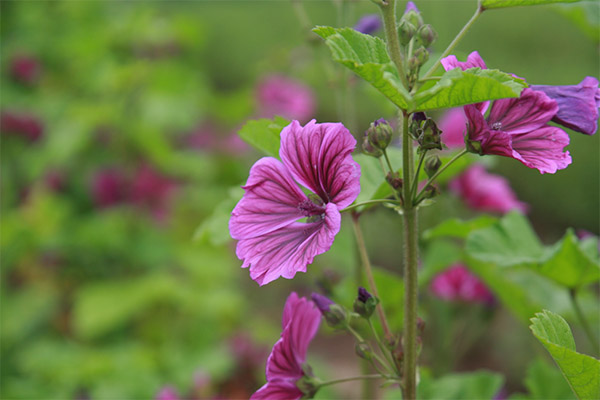
Infusion on mallow
To prepare such an infusion, you need to prepare the leaves and flowers of the plant. Place 1 tablespoon of the prepared ingredients in a glass of just boiled water. Cover the top of the infusion with a lid and put in a dark place for at least half an hour. During this time, the raw material will infuse and will be ready for use. Use it by half a glass in the morning, at lunch and in the evening.
Cold infusion on the leaves of the mallow tree
To prepare a cold infusion of the healing herb, you need to take 2 tablespoons of dry plant. Pour this powder with cold water. Be sure to boil the cold water before doing this. Leave the infusion for 8 hours to soak well. When it is completely ready, filter out the dry pieces of the herb. You can take the tincture no more than 2 times a day. Be sure to warm the liquid before using it internally.
Anti-inflammatory infusion
To prepare such a solution, it is necessary to take mallow as the basis, it will be used about 300 g. To it, it is also mandatory to add such herbs as mullein and chamomile, grains of stem-rose. Take all these components in a volume that is two times less than the mallow. Place the necessary raw materials in one bowl and pour 1 liter of freshly boiled water on top. Now the healing elixir should insist well, it happens within a whole day. At the end of this period, thoroughly strain the infusion through 2 layers of medical gauze. Now the decoction from the mallow is completely ready, it can be used for its intended purpose. This is done in the following way. Pour the liquid with the herbs completely into the bathtub. A person should take such healing water procedures before going to bed. Then he will quickly be able to cope with various inflammatory diseases of the spleen.
Infusion against a severe cough
To prepare such a healing infusion, use 50 flowers of mallow forest. They should be placed in a deep bowl and pour 1 tablespoon of boiling water on top. The solution should infuse for one hour. Then it can be used for internal use.
Infusion on stems and green leaves
For people who have various bronchial diseases, there is a good recipe using mallow. It is necessary to take the green stems and leaves of the plant, carefully crush them together. You will need about 40 grams of this potion. Here add 200 ml of boiling water and leave everything for 3 hours to infuse. After cooking, be sure to filter the infusion, after which it can be taken internally throughout the day.
Recipe for the juice of the mallow tree
This recipe will be extremely useful to those who have inflammation of the pancreas (in other words, pancreatitis). Taking this medicine 4 times a day will significantly improve the situation in a short time. Here you will need a special juice of the forest mallow, which was squeezed in a certain way from the green leaves and flowers of the plant at the time when it actively blossomed. The juice will need 1 tablespoon. Pour it into a glass of water at room temperature. Add there also 1 tablespoon of good honey. All thoroughly mix and drink.
Infusion helps with anemia.
You need to take 60 grams of powder from the dried roots of the plants and pour 1 tablespoon of good wine. Make sure that it must be white. Then put the infusion in a container and close with a lid. The jar should be placed in a dry and dark place for at least 3 weeks. During this period, be sure to shake the jar several times to avoid the formation of precipitation. After the liquid has infused, strain it thoroughly through layers of gauze. Drink this medicine at least 3 times a day. To do this, each time you need to measure out 60 ml of the drink.
Types of medicinal compositions
Forest mallow is rich in so many useful and unique chemical elements that it is widely used not only in folk medicine, but also in industrial medicine. In the manufacture of medicines are used all parts of the plant, from the roots to the flowers and seeds. There are many different recipes in folk medicine, including infusions, tinctures and decoctions on the mallow tree.
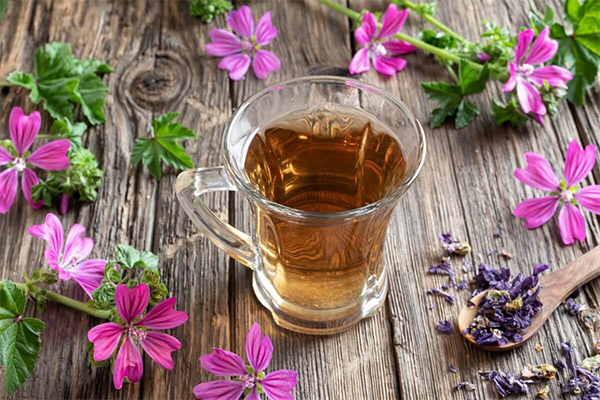
Infusion
The remedy is excellent for people with various diseases of the respiratory system. If there is a terrible cough, but it does not produce sputum, the best help is this infusion. It is also extremely useful for hoarse voice.
Tincture
Tinctures on mallow are most often prepared for external use. As a rule, they are used to wipe the skin of the face. Less often you can find special lotions on damaged areas of the body.
Decoction
In folk medicine, common decoctions of the forest mallow, which are used, as a rule, internally. It is prepared from the roots of the plant and is used for hardening of the liver. The same root decoction is also used externally. It is used to prepare poultices for ulcers and places where tumors have formed. Decoction, which uses not only the roots, but also the above-ground parts of the plant, is used for cardiovascular ailments.
Cosmetic applications
In the cosmetology industry, the mallow has long been considered a "genius of pure beauty. This definition is given to the plant for a reason. Everyone has long known its excellent anti-inflammatory properties. However, the wide range of mallow does not end there. Many have heard that this plant is capable of a large production of a special substance - melanin. That is why mallow infusions are often used as face lotions, which perfectly detoxify the skin and give it an unusual bronze tan.
Recipe for a mallow face lotion infusion
To prepare a miracle cure for the skin of the face, you will need 80 g of dried roots of the mallow forest. These raw materials should be poured white wine and cold (first boiled) water in a ratio of 1 to 1. Now the whole mixture is thoroughly shaken and put in a dark place for 2 weeks. When the infusion is ready, be sure to filter it through gauze. It can now be used to wipe the skin of the face daily.
Special extracts from the plant are also often used. They can be found among the ingredients of various medicinal gels, creams and tonics. Such products containing mallow forest mallow are extremely useful for overdry skin.
Girls who suffer from frequent occurrence of acne and facial contamination, perfectly suited any cosmetic preparations containing mallow forest. After all, the extracts contained in them, quickly have a therapeutic effect on the affected areas.
Few people know, but the same extracts from the plant are extremely useful for hair. And that is why they are often used among the ingredients of protective products (during straightening). To do this, you need to apply the liquid to the hair and do not rinse it off again. Also, this useful ingredient is widely used in shampoos and balms. Such preparations can quickly get rid of split ends.
Forest mallow in cooking
All plants of the Malva family have been actively used in cooking for thousands of years. They have always had a rich supply of nutrients. This practice was widely used in European countries. The leaves of this plant are great for frying and boiling but can also be eaten raw. The leaves can be used for soups and liquids. The mallow tree will give them an unusual and pleasant taste. The leaves can also be used to flavour teas. The seeds have a spicy, nutty flavor. Because of this abundance of possibilities, there are many unusual and very tasty culinary recipes using the wood mallow.
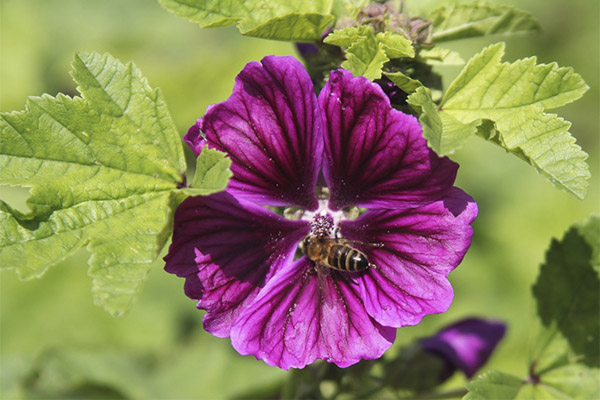
Wild Green Plant Soup
Ingredients:
Green herbs (including sorrel, bramble, plantain, sagebrush, clover, nettles, gnarled sting, quinoa, willow-herb, and forest mallow) - a bunch of each kind.
Potatoes - 3 tubers.
Process:
- Prepare an unusual and useful soup to begin with a thorough rinsing of greens. After that, finely chop each bunch. Next, pour all the green herbs heated to boiling water. You can also use hot broth, cooked on mushrooms, for this purpose.
- At this time, make a roasting of finely chopped roots and chopped onions. All together send to the boiling oil in a frying pan and bring to a golden color. When the roast is ready, send it to the pot with the greens.
- Now peel potatoes, wash them well and cut into small cubes. Cubes also send to the pot. Now turn on the fire and cook the soup until the potatoes are fully cooked.
- 15 minutes before removing from the fire, add a few bay leaves, a pinch of salt and pepper to the soup. Taste the potion. If it turns out to be too sour, this can easily be corrected with a spoonful of sugar.
Now you can serve the soup to the table. Be sure to add fresh sour cream or sour milk to it.
Egg omelet with medicinal herbs
Ingredients:
- Plantain leaves - 20 g.
- Mugwort - 10 gr.
- Butter - 15 gr.
- Stigmas tree - 10 gr.
- Large chicken eggs - 2 pieces.
- Mullein forest - 30 gr.
- Black pepper and salt - a pinch.
Method of preparation:
- Boil all the green plants thoroughly in boiling water, and then send to a pan in melted butter for 5 minutes, so that the greens are well stewed. At the same time, be sure to add spices, salt and pepper to taste. Further, these greens, cooked in a special way, will be used as minced meat.
- Now make a special mixture for making the omelette itself from dairy products, such as milk and eggs, making sure to add salt. Mix all the liquid thoroughly and send it to the frying pan, where the fat has been melted beforehand.
- Wait until the eggs begin to thicken slightly. At this point, place the green stuffing in the middle of the dish and wrap it on all sides of the still uncooked, omelet. When the dish is fully cooked, it can be served, making sure to turn the omelette pie with the stuffing upside down, placing it on the plate with the side where the seam is.
Okroshka with radish and mallow woodland
Ingredients:
- Green leaves of mallow forest - 300 g.
- Small radish - 2 pieces.
- Boiled potato tubers - 5 pieces.
- Fresh cucumber of small size - 2 pieces.
- Greens (dill and parsley) - 100 gr.
- Kvass or whey - 2 liters.
- Salt and black pepper - a pinch to taste.
Method of preparation:
- Fresh, green leaves of the forest mallow send to boiling water to boil them. Then cool them and then finely chop them.
- Pre-boiled potatoes are peeled and shredded into cubes.
- Next, coarsely grate a well-washed radish.
- Now put all the ingredients in one bowl, salt and pepper well and mix thoroughly. Then put the dish in the refrigerator for at least an hour and a half.
- After that, dress the cold salad with finely chopped greens and dress it with kvass or whey.
The dish is ready, it can be served. It is important not to forget the fresh cold sour cream.
Potato casserole with mallow forest and herbs
Ingredients:
- Fresh milk - 30 g.
- Chicken eggs - 3 pieces.
- Mullein forest greens - 90 gr.
- Rushes - 60 gr.
- Pinworm - 70 gr.
- Plantain leaves - 60 gr.
- Salt and pepper - a pinch to taste.
Method of preparation:
- The first thing to do is to mashed potato the potatoes. Rinse potato tubers thoroughly under running water. Next, peel them, cut into small cubes (so the potatoes will cook much faster and easier to grind). Send the potato pieces to a saucepan, pour water and send to the fire. Be sure to salt the future mashed potatoes well at the beginning of cooking. When the potatoes are cooked, add butter and heated milk. Now grind it well, and then whip it with a blender to the state of sour cream.
- In the next step, prepare all the greens. To do this, send it under running water to rinse well. Then chop the leaves and stems thoroughly. Ready plants send in a pot with boiling and salted water. After the herb is well scalded, take it off the heat, drain the water and allow to cool well.
- In the meantime, prepare an omelet liquid of eggs and milk. Mix the two products well, beat with a fork. Then be sure to add salt, ground black pepper and the necessary spices.
- Now all the ingredients are ready for cooking potato casserole with greens. To do this, you will need a voluminous dish with rims. Heat it a little and thoroughly grease it. There send mashed potatoes, followed by boiled greens. Pour the omelet liquid together and season well with spices, pepper and salt. Put the dish with the ingredients in the oven. Watch for cooking every few minutes. As soon as a delicious, golden crust appears, the dish can be taken out, cooled and served.
Braised wild mallow with herbs
Ingredients:
- Malva forest (greens) - 40 g.
- Ginger mallow - 20 grams.
- Greens of elderberry - 20 grams.
- Plantain green (leaves) - 30 g.
- Dandelion greens - 20 g.
- Sorrel leaves - 15 g.
- Onion - 40 gr.
- Carrot - 20 gr.
- Wheat flour - 15 gr.
- Salt, black pepper and spices - a pinch to taste.
Method of preparation:
- First, gather all the greens in one bowl and rinse them thoroughly under running water. Then wipe the wet greens and finely chop them with a knife.
- Immediately put all the pieces of herbs in the boiling water and slowly stew, stirring all the time.
- In the meantime, wash the onions and carrots, peel them, chop them as needed, and send them to be steamed in oil. To the onions and carrots also add washed and chopped sorrel.
- When the herbs in the dish is almost ready, add to it the pasted ingredients. Separately, at this time, pass black ground pepper, salt, spices and flour. At the moment when the greens are completely softened, add the mixture of spices and flour to it. Now stir the dish thoroughly, remove from the heat, cool it and serve in portions.
Contraindications for use
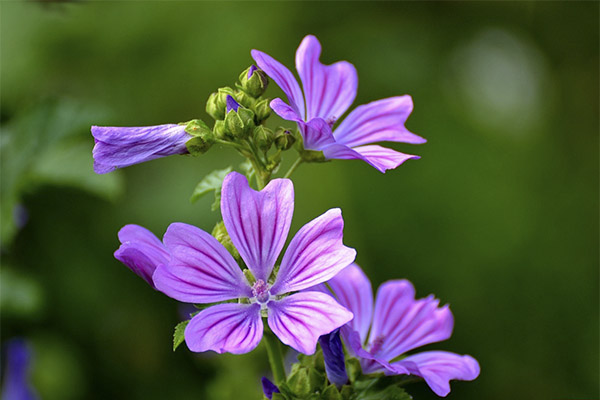
There are many species and subspecies in the Malva family. You often hear different species referred to equally as wood malva. This is because all the plants are very similar, and people may not understand them. This is why it is very important, when choosing a plant, to make sure that it is the forest mallow. Otherwise, you will not be able to avoid side effects when using it.
Strangely enough, but the mallow forest is the plant that has almost no contraindications. The only thing to consider is the individual intolerance of preparations containing in the plant, to exclude allergies.
«Important: All information on the site is provided solely for introductory purposes only. Before applying any recommendations, you should consult with a specialized health care professional before using any of the recommendations. Neither the editors nor the authors shall be liable for any possible harm caused by materials."

